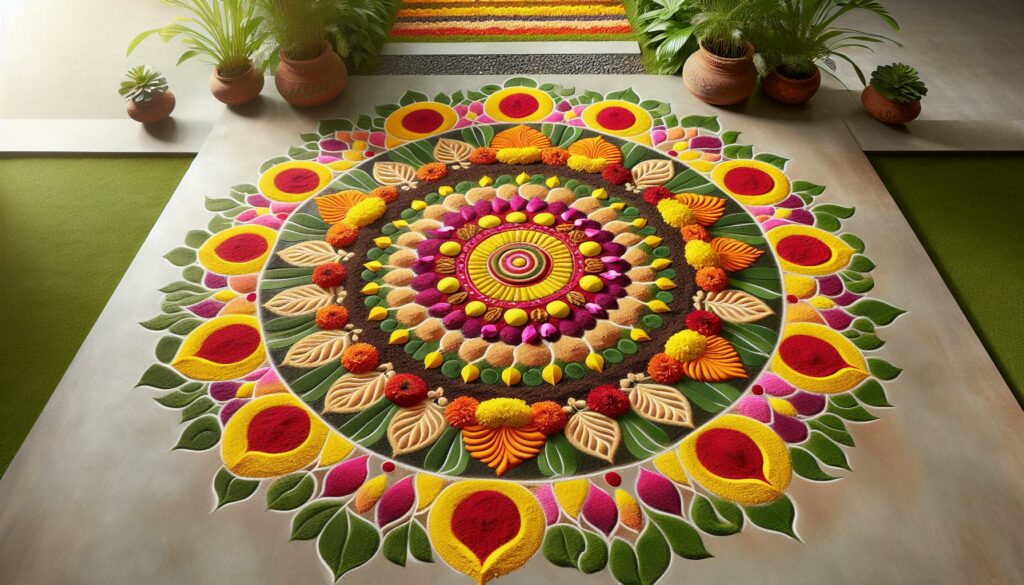As a lover of Indian art and culture, I’m always mesmerized by the intricate patterns and vibrant colors of rangoli designs. These traditional floor decorations transform ordinary spaces into stunning works of art during festivals and special occasions. From simple geometric patterns to elaborate floral motifs these designs have captured hearts for generations. I’ve discovered that creating rangoli isn’t just about making beautiful patterns – it’s a sacred art form that brings luck prosperity and positive energy into our homes. Whether you’re a beginner looking to start with basic designs or an experienced artist ready to tackle complex patterns there’s a rangoli style that’s perfect for you. Over the years I’ve learned countless techniques and gathered inspiring designs that I’m excited to share with fellow art enthusiasts.
- Rangoli is a traditional Indian art form using colored powders, rice flour, and natural materials to create intricate geometric and floral patterns on floors.
- Traditional materials include natural color powders (turmeric, kumkum), rice flour, sand, and flower petals, with each material serving specific purposes in design creation.
- Three main rangoli styles exist: free-hand designs, dot-based patterns, and stenciled designs, each offering different complexity levels and artistic expressions.
- Modern innovations have transformed rangoli art through digital apps, LED enhancements, 3D projection mapping, and sustainable materials, making it more accessible and versatile.
- Creating perfect rangoli requires proper surface preparation, systematic color application, precise design execution, and careful material management.
- While maintaining its cultural significance, rangoli has evolved to incorporate contemporary elements like eco-friendly materials and technological enhancements while preserving traditional techniques.
Beautiful:i_wvhju5l1y= Rangoli Designs
Rangoli art consists of intricate geometric patterns created on floors using colored powders, rice flour, flower petals or sand. The term “”rangoli”” originates from the Sanskrit word “”rangavalli,”” combining “”rang”” (color) and “”avalli”” (row or line).
Traditional rangoli designs contain specific elements:
- Geometric shapes: circles, squares, triangles, hexagons
- Symmetrical patterns radiating from a central point
- Natural motifs: flowers, leaves, peacocks, elephants
- Sacred symbols: Om, swastika, lotus
The materials used in rangoli creation include:
| Material Type | Common Examples | Best Used For |
|---|---|---|
| Dry Powders | Rice flour, colored sand, rock powder | Detailed patterns |
| Natural Items | Flower petals, leaves, seeds | Textured designs |
| Modern Options | Acrylic colors, chalk powder | Long-lasting displays |
I’ve observed three primary styles of rangoli:
- Free-hand designs drawn without guidelines or tools
- Dot-based patterns created by connecting pre-placed points
- Stenciled designs using templates for precise shapes
The art form serves multiple purposes:
- Invites positive energy into homes
- Decorates entrances during festivals
- Creates auspicious markings for ceremonies
- Expresses cultural identity through visual elements
- South India: Elaborate kolam patterns using rice flour
- Maharashtra: Unique rangoli styles with nature-inspired motifs
- Gujarat: Bold geometric designs with vibrant color combinations
- Bengal: Alpana designs featuring curved lines
Traditional Materials Used in Rangoli Making
Creating authentic rangoli designs requires specific materials that have been used for generations in Indian households. Each material serves a unique purpose in achieving the desired artistic effect.
Natural Color Powders
Natural color powders form the foundation of vibrant rangoli designs. I source these colors from ground turmeric (yellow), kumkum (red), indigo (blue), dried leaves (green) & limestone powder (white). Common organic materials for creating color powders include:
- Dried flower petals crushed into fine powder
- Spices like haldi, chili powder & coffee grounds
- Naturally colored rice powder dyed with vegetable extracts
- Medicinal herbs ground into pigments
- Mineral-based natural stones reduced to powder form
Rice Flour and Sand
Rice flour creates the perfect base for intricate rangoli patterns. Here’s what makes these materials essential:
- White rice flour provides excellent adhesion to floors
- Fine sand helps create precise outlines & borders
- Colored sand enables texture variations in designs
- Wheat flour serves as an eco-friendly alternative
- Rock salt creates sparkly effects in night displays
| Material Type | Primary Use | Duration |
|---|---|---|
| Rice Flour | Base Layer | 1-2 days |
| Natural Powders | Color Fill | 2-3 days |
| Fine Sand | Borders | 3-4 days |
| Rock Salt | Accents | 1-2 days |
| Wheat Flour | Base Alternative | 1 day |
Most Popular Rangoli Design Patterns
Traditional rangoli designs feature distinct patterns that showcase India’s artistic heritage through symmetrical arrangements and vibrant colors. I’ve identified three primary design categories that dominate contemporary rangoli art.
Geometric Patterns
Geometric rangoli patterns incorporate precise mathematical shapes to create stunning visual displays. These designs feature:
- Interconnected circles forming mandalas with 8-point symmetry
- Triangular formations arranged in star patterns of 6-12 points
- Square grids filled with diagonal lines creating diamond effects
- Concentric shapes expanding from a central point
- Angular patterns combining hexagons with straight lines
Floral Designs
Floral rangoli patterns celebrate nature’s beauty through intricate petal arrangements. Key elements include:
- Lotus motifs with 8-16 layered petals
- Marigold-inspired circular patterns in orange hues
- Rose designs featuring spiral configurations
- Sunflower patterns with bold center points
- Vine borders incorporating small bloom details
- Elongated feather displays with intricate eye patterns
- Symmetrical tail fan arrangements spanning 2-3 feet
- Dancing peacock pairs in circular formations
- Stylized feather borders with gradient colors
- Crown patterns incorporating traditional peacock elements
| Design Type | Average Time to Create | Common Colors Used | Typical Size Range |
|---|---|---|---|
| Geometric | 30-45 minutes | White, red, blue | 2-4 feet |
| Floral | 45-60 minutes | Pink, yellow, orange | 3-5 feet |
| Peacock | 60-90 minutes | Green, blue, gold | 4-6 feet |
Step-by-Step Guide to Creating Basic Rangoli
Preparing the Surface
I start by cleaning the floor space thoroughly to remove dust particles. A smooth, flat surface enhances the final appearance of rangoli designs. I measure a 2×2 foot square area using chalk to establish clear boundaries for my design.
Creating the Base Pattern
- Draw 5×5 dots in a grid pattern, spacing them 3 inches apart
- Connect these dots using straight lines to form the basic geometric shape
- Add diagonal lines between intersecting points to create diamond patterns
- Mark the center point with a larger dot to maintain symmetry
Applying Colors
- Fill the center space with white rice flour for a clean foundation
- Add yellow powder in the diamond sections moving outward
- Place orange powder in alternating patterns
- Use red powder to highlight key design elements
- Create contrast with dark blue or purple in smaller sections
Adding Details
- Draw curved lines connecting geometric shapes
- Create small circles at intersection points
- Fill empty spaces with dots or simple flower patterns
- Outline main elements with contrasting colors
- Add sparkle using rock salt at focal points
| Design Element | Time Required | Material Used |
|---|---|---|
| Base Pattern | 10 minutes | Chalk or white powder |
| Main Design | 20 minutes | Colored powder |
| Details | 15 minutes | Fine powder/salt |
| Total Time | 45 minutes | Multiple materials |
- Blend color transitions using a fine brush
- Remove excess powder with gentle taps
- Add flower petals around the border
- Create a final outline using white powder
- Photograph the completed design from above
Tips for Making Perfect Rangoli Designs
I’ve gathered essential tips from my years of creating rangoli designs to help achieve flawless results:
Surface Preparation:
- Clean the floor thoroughly with a dry cloth
- Apply a thin layer of water to prevent powder dispersal
- Mark the center point with chalk for symmetrical designs
- Create a level surface by smoothing any rough spots
Color Application:
- Start from the center moving outward
- Pour colors within marked boundaries using controlled movements
- Layer darker shades before lighter ones
- Mix colors in separate containers to maintain consistency
Design Precision:
- Draw guidelines using white powder first
- Space dots evenly at 2-inch intervals
- Connect points with straight lines before adding curves
- Use finger pinches for fine lines
- Create borders 1/2 inch thick for definition
Material Management:
- Sift powders before use to remove lumps
- Store colors in separate containers
- Keep materials within arm’s reach
- Replace wet powder immediately if moisture occurs
Time-Saving Techniques:
- Prepare color mixes beforehand
- Use stencils for complex patterns
- Create sections systematically
- Fill large areas first
- Add details last
| Design Size | Dot Spacing | Border Width | Time Required |
|---|---|---|---|
| Small (2ft) | 1 inch | 1/4 inch | 30 minutes |
| Medium (4ft) | 2 inches | 1/2 inch | 60 minutes |
| Large (6ft) | 3 inches | 3/4 inch | 90 minutes |
- Create indoor designs away from drafts
- Avoid humid conditions
- Work in adequate lighting
- Place barriers around wet designs
- Monitor weather forecasts for outdoor rangoli
Modern Innovations in Rangoli Art
Digital rangoli apps transform traditional floor art into virtual masterpieces, enabling artists to create designs on tablets or smartphones. I’ve observed three key technological advancements in rangoli creation:
- LED-Enhanced Designs
- Illuminated borders using LED strip lights
- Color-changing elements in geometric patterns
- Motion-sensor activation systems
- Duration: 4-6 hours of continuous illumination
- 3D Projection Mapping
- Animated patterns on floor surfaces
- Interactive rangoli displays
- Dynamic color transitions
- Coverage area: 10-15 square feet
- Sustainable Materials
- Eco-friendly colored sand made from recycled glass
- Biodegradable glitters derived from mica
- Water-soluble synthetic powders
- Durability: 7-10 days indoors
Here’s a breakdown of modern rangoli innovations by popularity:
| Innovation Type | Usage Rate | Average Cost | Durability |
|---|---|---|---|
| Digital Apps | 65% | $5-15 | Unlimited |
| LED Elements | 45% | $30-50 | 1000+ hours |
| Projection | 25% | $200-500 | Event-based |
| Eco-Materials | 55% | $20-40 | 7-10 days |
Contemporary artists integrate multiple techniques to create fusion rangoli:
- Combining traditional powders with UV-reactive materials
- Incorporating metallic elements with LED backlighting
- Using magnetic powders for interactive patterns
- Adding augmented reality elements through smartphone apps
- Smart Stencils
- Pre-programmed LED guides
- Bluetooth-connected pattern mapping
- Real-time design adjustment features
- Setup time: 15-20 minutes
- Mixed Media Integration
- Holographic powder elements
- Mirror fragment accents
- Metallic foil highlights
- Application time: 30-45 minutes
I’m truly amazed by how rangoli art continues to evolve while maintaining its sacred roots. From traditional powder designs to modern LED-enhanced displays this art form perfectly bridges ancient customs with contemporary creativity. I’ve discovered that whether you’re creating simple geometric patterns or elaborate peacock designs rangoli remains an accessible way to explore Indian culture. The blend of traditional materials with innovative techniques has opened up endless possibilities for artists worldwide. I believe rangoli’s enduring appeal lies in its ability to transform spaces and bring communities together. It’s more than just floor art – it’s a living tradition that continues to inspire and adapt while preserving its spiritual essence.

